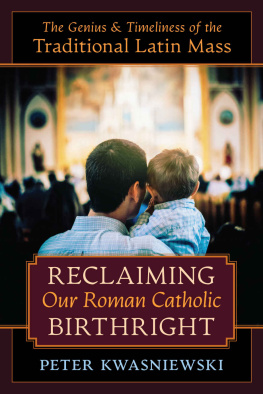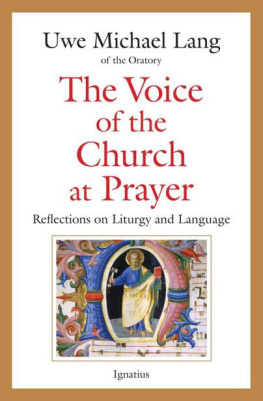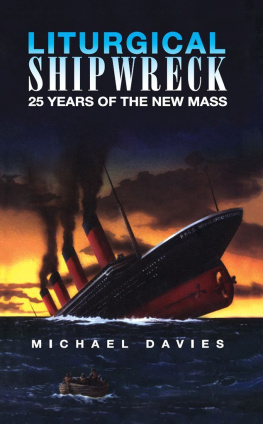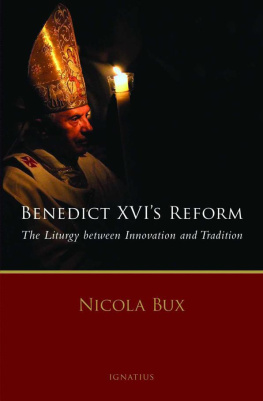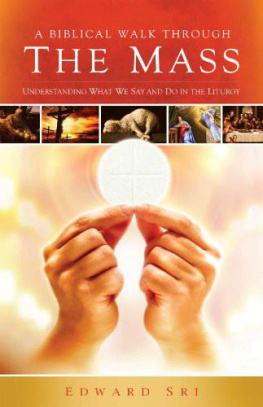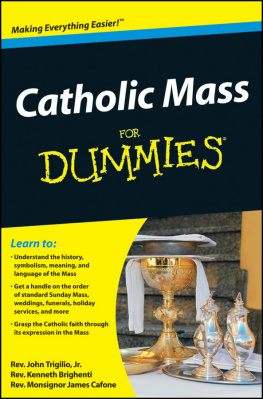Michael Davies - A Short History of the Roman Mass
Here you can read online Michael Davies - A Short History of the Roman Mass full text of the book (entire story) in english for free. Download pdf and epub, get meaning, cover and reviews about this ebook. year: 0, publisher: TAN Books, genre: Religion. Description of the work, (preface) as well as reviews are available. Best literature library LitArk.com created for fans of good reading and offers a wide selection of genres:
Romance novel
Science fiction
Adventure
Detective
Science
History
Home and family
Prose
Art
Politics
Computer
Non-fiction
Religion
Business
Children
Humor
Choose a favorite category and find really read worthwhile books. Enjoy immersion in the world of imagination, feel the emotions of the characters or learn something new for yourself, make an fascinating discovery.
- Book:A Short History of the Roman Mass
- Author:
- Publisher:TAN Books
- Genre:
- Year:0
- Rating:3 / 5
- Favourites:Add to favourites
- Your mark:
- 60
- 1
- 2
- 3
- 4
- 5
A Short History of the Roman Mass: summary, description and annotation
We offer to read an annotation, description, summary or preface (depends on what the author of the book "A Short History of the Roman Mass" wrote himself). If you haven't found the necessary information about the book — write in the comments, we will try to find it.
A Short History of the Roman Mass — read online for free the complete book (whole text) full work
Below is the text of the book, divided by pages. System saving the place of the last page read, allows you to conveniently read the book "A Short History of the Roman Mass" online for free, without having to search again every time where you left off. Put a bookmark, and you can go to the page where you finished reading at any time.
Font size:
Interval:
Bookmark:
A Short History
of the
Roman Mass
Michael Davies
Copyright 1997 TAN Books. (The copyright covers all new material plus this particular arrangement of existing material.)
Library of Congress Catalog Card No.: 96-61302
Cover portrait of St. Pius V painted by Jacopino Del Conte (1510-1598), official portraitist in the Vatican from Pope Paul IV to Pope Clement VIII. The portrait is the property of Mario Seno, President of Una Voce Italy, and is used with his permission.
TAN Books
Charlotte, North Carolina
www.TANBooks.com
1997
A SHORT HISTORY OF THE ROMAN MASS is on a topic of immense importance, for the Mass is at the very heart of the Catholic religion. Our ancient liturgical tradition, the "Tridentine" Mass, has borne fruits of holiness and salvation for centuries, and it still bears these fruits when it is celebrated today. Keeping our ancient Catholic liturgical traditions is a key to keeping the Catholic Faith and to saving our souls. Therefore, we are making this booklet available at the lowest possible prices for quantity distribution in order to reach as many people as possible. The issue is the salvation of souls and peace in the world.
Quantity discounts are available.
Visit your Bookdealer or purchase directly
from the Publisher.
Please go to www.TANBooks.com
or call us at 800-437-5876
for more information.
TAN Books
Charlotte, North Carolina
www.TANBooks.com
"Our Mass goes back, without essential change, to the age when it first developed out of the oldest liturgy of all. It is still redolent of that liturgy, of the days when Ceasar ruled the world and thought he could stamp out the faith of Christ, when our fathers met together before dawn and sang a hymn to Christ as to a God. The final result of our enquiry is that, in spite of unsolved problems, in spite of later changes, there is not in Christendom another rite so venerable as ours."
Fr. Adrian Fortescue
The Mass: A Study of the
Roman Liturgy (1912), p.213
"From roughly the time of St. Gregory [d. 604] we have the text of the Mass, its order and arrangement, as a sacred tradition that no one has ventured to touch except in unimportant details."
Fr. Adrian Fortescue
The Mass: A Study of the
Roman Liturgy (1912), p. 173
AUTHOR'S NOTE
This booklet is in large part a compilation of material from Father Adrian Fortescue's classic work, The Mass: A Study of the Roman Liturgy (London: Longmans, 1912). Although certain notable passages are referenced, my debt to this great priest and scholar actually goes far beyond these. I hope hereby to bring to today's readers some of the fruits of Father Fortescue's book, which is now rare and out of print. I hope also, in the near future, to publish an extensive compilation of Father Fortescue's writings on the Mass.
Michael Davies
A SHORT HISTORY OF THE ROMAN MASS
T HE first source for the history of the Mass is obviously the account of the Last Supper in the New Testament. It was because Our Lord told us to do what He had done, in memory of Him, that Christian liturgies exist. No matter in which respects there are differences in the various Eucharistic liturgies they all obey His command to do "this," namely what He Himself had done. A definite pattern for the celebration of the Eucharist had developed within decades of the death of Our Lord, a pattern which was carried on well past the conclusion of the 1st century, and which can still be discerned clearly in the finalized Roman Mass of 1570.
THE EARLY CATHOLIC LITURGY
The earliest and most detailed account of the Eucharist is found in St. Paul's First Epistle to the Corinthians, which, of course, predates the Gospels, and was written in Ephesus between 52-55 A.D. Scholars agree that the Consecration formula used by St. Paul in 1 Corinthians, Chapter 11, quotes verbatim from a stylized formula already in use in the Apostolic liturgy. St. Paul's account reads:
For I have received of the Lord that which also I delivered unto you, that the Lord Jesus, the same night in which He was betrayed, took bread, and giving thanks, broke, and said: Take ye, and eat: This is My Body, which shall be delivered for you: this do for the commemoration of Me.
In like manner also the chalice, after He had supped, saying: This chalice is the new testament in My Blood: this do ye, as often as you shall drink, for the commemoration of Me. For as often as you shall eat this Bread, and drink the Chalice, you shall show the death of the Lord, until He come.
Therefore whosoever shall eat this Bread, or drink the Chalice of the Lord unworthily, shall be guilty of the Body and of the Blood of the Lord. (1 Cor. 11:23-27).
The passage is rich in doctrine. It identifies the Eucharist with the Passion. A new and permanent covenant or alliance is concluded between God and man in the Blood of Jesus. His sacrifice was mystically anticipated at the Last Supper. The Apostles, and implicitly their successors, are commanded to celebrate the Eucharist in His memory; and this remembrance is of such efficacy that it is an unceasing proclamation of His redemptive death, and renders it actually present until the day when He returns in the full glory of His Second coming. The Eucharist is the memorial of the Passion, anamnesis in Greek, and it commemorates the Passion by renewing it in an unbloody manner upon the altar. Finally, great purity of soul is required to take part in a rite as sacred as the offering and reception of the Body and Blood of Our Saviour.
By combining St. Paul's account with those of the four synoptic Gospels, we have the essentials of the Eucharistic liturgy in every ancient rite. Our Lord took bread, gave thanks, blessed and broke it, and gave it to His Apostles to eat; then He took a cup of wine, again gave thanks (Luke and Paul do not add this second thanksgiving), said the words of Institution (or Consecration) over it, and gave it to them to drink. We thus have the five essential elements for the Christian Eucharist: 1) Bread and wine are brought to the altar; 2) The celebrant gives thanks; 3) He takes bread, blesses it and says the words of Consecration; 4) He does the same over the wine; 5) The consecrated Bread, now having become the Body of Christ, is broken and is given to the people in Communion together with the contents of the Chalice, that is, the Precious Blood.
Our knowledge of the liturgy increases considerably in the 2nd century, and special reference must be made to the testimony of a pagan Roman the younger Pliny (C. Plinius Caecilius, c.62-113), at that time Governor of Bithynia (modern Northwest Turkey). About the years 111-113 he writes to his master, the Emperor Trajan, to ask how he is to treat Christians. He describes what he has learned about them from Christians who had apostatized under torture. Referring to his apostate informers, he writes with satisfaction: "All have worshiped your image and the statues of the gods and have cursed Christ." Then he recounts what the apostates revealed about Christian worship:
They assert that this is the whole of their fault or error, that they were accustomed on a certain day (stato die) to meet together before daybreak (ante lucem), and to sing a hymn alternately (secum invicem) to Christ as a god, and that they bound themselves by an oath (sacramento) not to do any crime, but only not to commit theft nor robbery nor adultery, not to break their word nor to refuse to give up a deposit. When they had done this, it was their custom to depart, but to meet again to eat food ordinary and harmless food however. They say that they [the apostate informers] have stopped doing this after my edict which forbade private assemblies
Next pageFont size:
Interval:
Bookmark:
Similar books «A Short History of the Roman Mass»
Look at similar books to A Short History of the Roman Mass. We have selected literature similar in name and meaning in the hope of providing readers with more options to find new, interesting, not yet read works.
Discussion, reviews of the book A Short History of the Roman Mass and just readers' own opinions. Leave your comments, write what you think about the work, its meaning or the main characters. Specify what exactly you liked and what you didn't like, and why you think so.

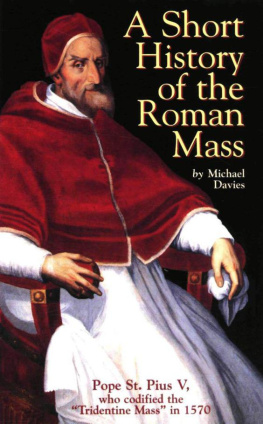


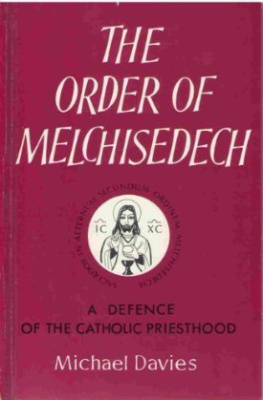

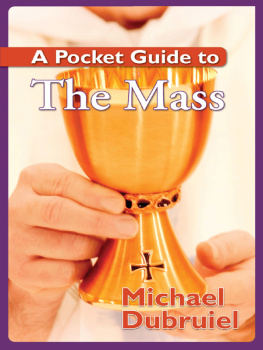
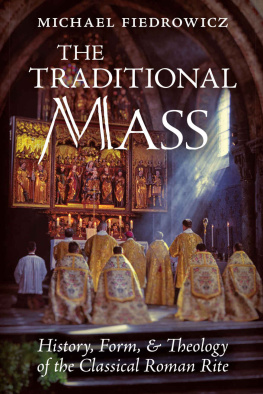
![Pope John XXIII - The Roman Missal [1962]](/uploads/posts/book/272720/thumbs/pope-john-xxiii-the-roman-missal-1962.jpg)
